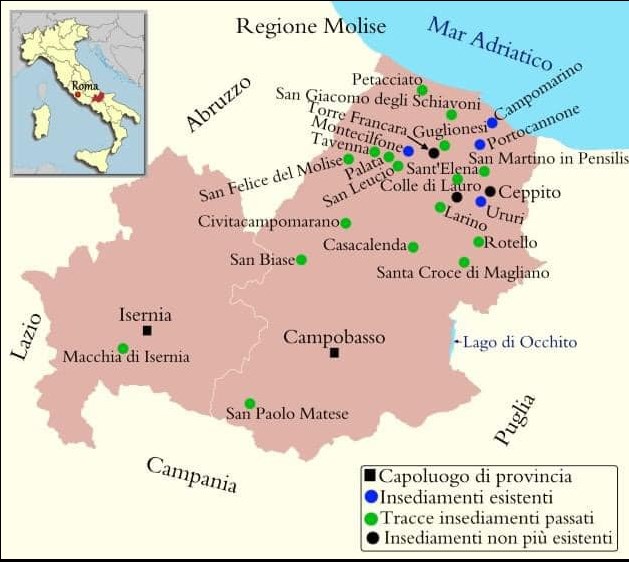La costa adriatica del Molise, così come quella della Puglia, era la costa più vicina ai Balcani che consentiva gli sbarchi dei profughi provenienti da quei paesi che fuggivano dalla conquista ottomana dei Balcani.
Sia gli Slavi ( Croati / Dalmatia) che gli Arbëreshë erano giunti nel Molise già prima del XIV secolo, ma il loro arrivo si intensificò nella seconda metà del XV secolo.
I Croati dl Molise sono, Acquaviva Collecroce (Živavoda Kruč), Montemitro (Mundimitar) e San Felice del Molise (Filić).
Arbereshe.
Sono stati identificati 27 insediamenti arbëreshë, oramai quasi tutti scomparsi, i quali sono nati in tempi diversi nel corso degli ultimi cinque secoli e, in particolare, nei secoli XV e XVI.
In questi insediamenti, col passare del tempo l’antica lingua dei padri si è parlata sempre meno o, partendo da questi insediamenti, gli Arbëreshë si sono spostati in altre località del Molise e soprattutto nel sud Italia.
Inoltre, a causa di una lenta assimilazione, a cominciare dalla scoparsa del rito bizantino, degli elementi culturali, dei costumi, delle tradizioni, ecc., gli insediamenti Arbëreshë sono andati man mano scomparendo quasi tutti.
La maggior parte degli Arbëreshë si stabilirono nella provincia Campobasso e più precisamente a: Campomarino (in arbëresh: Këmarini), Casacalenda e la sua frazione di San Barbato, Campomarino (in lingua arbëreshe: Këmarini), Casale Sant’Elena, Ceppito, Civitacampomarano, Guglionesi, Larino e la sua frazione di Colle di Lauro, Montecilfone (in lingua arbëreshe: Munxhufuni) con la sua contrada di Torre Francara, Palata e la sua frazione di San Leucio, Pettacciato, Portocannone (in lingua arbëreshe: Portkanuni), Rotello, San Biase, San Felice del Molise, San Giacomo degli Schiavoni, San Martino in Pensilis e la sua frazione di San Leo, San Paolo Matese, Santa Croce di Magliano, Tavenna e Ururi (in lingua arbëreshe: Ruhr). Mentre nella provincia di Isernia gli Arbëreshë si stabilirono a Macchia d’Isernia e a Sant’Elena Sannita.
Oggi nel Molise le sole comunità etno-linguistiche degli Arbëreshë che consevano ancora tracce storico-culturali sono tutte nella Provincia di Campobasso, e più precisamente:
Campomarino (in arbëresh: Këmarini),
Portocannone (in lingua arbëreshe: Portkanuni),
Ururi (in lingua arbëreshe: Ruhr) e
Montecilfone (in lingua arbëreshe: Munxhufuni)
con la sua contrada di Torre Francara,
dove sono ancora evidenti tracce del patrimonio storico e del patrimonio culturale.
—————————————–Shqip————-
Arbëreshe nga Molise.
Bregdeti Adriatik i Molise, si dhe ai i Pulias, ishte bregdeti më i afërt me Ballkanin që lejoi zbarkimin e refugjatëve nga ato vende që iknin nga pushtimi osman i Ballkanit.
Të dy sllavët (kroatët / dalmatët) dhe arbëreshët kishin mbërritur në Molise para shekullit të 14-të, por ardhja e tyre u intensifikua në gjysmën e dytë të shekullit të 15-të.
Kroatët nga Molise janë, Acquaviva Collecroce (Živavoda Kruč), Montemitro (Mundimitar) dhe San Felice del Molise (Filić).
arbëreshe. Janë identifikuar 27 vendbanime arbëreshe, tashmë pothuajse të gjitha të zhdukura, të cilat kanë lindur në periudha të ndryshme gjatë pesë shekujve të fundit dhe, veçanërisht, në shekujt XV dhe XVI.
Në këto vendbanime, me kalimin e kohës flitej gjithnjë e më pak gjuha e lashtë e etërve ose, duke u nisur nga këto vendbanime, arbëreshët u shpërngulën në vende të tjera në Molise dhe veçanërisht në Italinë e Jugut.
Më tej, për shkak të një asimilimi të ngadaltë, duke filluar me zhdukjen e ritit bizantin, të elementeve kulturore, zakoneve, traditave etj., vendbanimet arbëreshe janë zhdukur gradualisht.
Shumica e arbëreshëve u vendosën në provincën Campobasso dhe më saktë në: Campomarino (në arbërisht: Këmarini), Casacalenda dhe fshati i saj San Barbato, Campomarino (në gjuhën arbëreshe: Këmarini), Casale Sant’Elena, Ceppito, Civitacampomarano, Guglionesi, Larino dhe fshati i tij Colle di Lauro, Montecilfone (në gjuhën arbëreshe: Munxhufuni) me rrethin e tij Torre Francara, Palata dhe fshatin e tij San Leucio, Pettacciato, Portocannone (në gjuhën arbëreshe: Portkanuni), Rotello, San Biase, San Felice. del Molise, San Giacomo degli Schiavoni, San Martino in Pensilis dhe fshati i tij San Leo, San Paolo Matese, Santa Croce di Magliano, Tavenna dhe Ururi (në gjuhën arbëreshe: Ruhr). Ndërsa në provincën e Isernias arbëreshët u vendosën në Macchia d’Isernia dhe në Sant’Elena Sannita.
Sot në Molise të vetmet bashkësi etno-gjuhësore të arbëreshëve që ruajnë ende gjurmë historiko-kulturore janë të gjitha në Provincën e Campobasso-s dhe më saktë:
Campomarino (në arbëreshe: Këmarini),
Portocannone (në gjuhën arbëreshe: Portkanuni),
Ururi (në gjuhën arbëreshe: Ruhr) e
Montecilfone (në gjuhën arbëreshe: Munxhufuni)
me rrethin e saj Torre Francara,
ku janë ende të dukshme gjurmët e trashëgimisë historike dhe kulturore.
————————————English———-
Arbereshe from Molise.
The Adriatic coast of Molise, as well as that of Puglia, was the coast closest to the Balkans which allowed the landing of refugees from those countries fleeing the Ottoman conquest of the Balkans.
Both the Slavs (Croatians / Dalmatians) and the Arbëreshë had arrived in Molise already before the 14th century, but their arrival intensified in the second half of the 15th century.
The Croats from Molise are, Acquaviva Collecroce (Živavoda Kruč), Montemitro (Mundimitar) and San Felice del Molise (Filić).
Arbereshe.
27 Arbëreshë settlements have been identified, now almost all disappeared, which were born at different times over the last five centuries and, in particular, in the 15th and 16th centuries.
In these settlements, over time the ancient language of the fathers was spoken less and less or, starting from these settlements, the Arbëreshë moved to other locations in Molise and especially to southern Italy.
Furthermore, due to a slow assimilation, starting with the disappearance of the Byzantine rite, of cultural elements, customs, traditions, etc., the Arbëreshë settlements have gradually disappeared.
Most of the Arbëreshë settled in the Campobasso province and more precisely in: Campomarino (in Arbëresh: Këmarini), Casacalenda and its hamlet of San Barbato, Campomarino (in Arbëresh language: Këmarini), Casale Sant’Elena, Ceppito, Civitacampomarano, Guglionesi, Larino and its hamlet of Colle di Lauro, Montecilfone (in Arbëreshe language: Munxhufuni) with its district of Torre Francara, Palata and its hamlet of San Leucio, Pettacciato, Portocannone (in Arbëreshe language: Portkanuni), Rotello, San Biase, San Felice del Molise, San Giacomo degli Schiavoni, San Martino in Pensilis and its hamlet of San Leo, San Paolo Matese, Santa Croce di Magliano, Tavenna and Ururi (in Arbëreshe language: Ruhr). While in the province of Isernia the Arbëreshë settled in Macchia d’Isernia and in Sant’Elena Sannita.
Today in Molise the only ethno-linguistic communities of the Arbëreshë that still retain historical-cultural traces are all in the Province of Campobasso, and more precisely:
Campomarino (in Arbëresh: Këmarini),
Portocannone (in Arbëreshe language: Portkanuni),
Ururi (in Arbëreshe language: Ruhr) e
Montecilfone (in Arbëreshe language: Munxhufuni)
with its district of Torre Francara,
where traces of the historical and cultural heritage are still evident.
Marre nga: Gian Della Riina
Biblioteka Portkanuni ( Portocannone)/Federata Shoqatave Shqiptare Itali FAAI







































